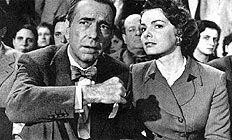|
|
|
|
The
Barefoot Contessa
|
 |
|
The surface appeal of Joseph Mankiewicz's very personal project The Barefoot Contessa is obvious: Ava Gardner at her most glamorous as the rags-to-riches star Maria alongside Humphrey Bogart at his most acerbic and yet tender as filmmaker Harry; the flood of quotable quotes in the dialogue ("It's never too late to develop character"); the intriguing allusions to real-life celebrities including Rita Hayward and Howard Hughes. But there is much more going on below the surface. The Barefoot Contessa owes a lot to Citizen Kane (1941), especially the mosaic structure which offers various points of view on a character – this structure ultimately affirming only the inscrutability of that person. Mankiewicz gives this form an elegant shape: using the initial springboard situation of Maria's funeral, there are eight flashbacks from four separate narrators, a camera movement taking us from one "inner reminiscer" to the next. Long before Pulp Fiction (1994), Mankiewicz contrives an inspired sequence which shows Maria's transition from Bravano (Marius Goring) to Vincenzo (Rossano Brazzi) from two quite different viewpoints, each with its own particular mise en scène. Even more intricate is the film's journey through three distinct social worlds – Hollywood show business, the French leisure set, and Italian aristocracy – that register as uncanny variations on each other, each one enclosed, decadent, and dying. Indeed, this suite of decay echoes the presentation of the theatre world in Mankiewicz's classic All About Eve (1950) – a not insignificant comparison. While his films are sometimes (with justice) criticised as stagey and word-bound, the richness and coherence of The Barefoot Contessa is created by its insistent metaphor of theatrical spectacle: all these social spaces are ones in which some people pose and others stare. No wonder Mankiewicz's signature touch is the "freeze" in which the plot stops and a narrator fills us in on the character and backdrop of each "layer" at a table. The Barefoot Contessa is fascinating today as a film that dances around various "unspeakable" topics. What defines – and eventually kills – Maria is the split in her life between a Cinderella-style dream of transcendent fulfilment, and her taste for rough, "peasant" sex, signified by the moments when she abandons her "slippers". Vincenzo and his sister, Eleanora (Valentina Cortese), add up to an even darker case study: although the script explains their "dying clan" through references to his war wound and her infertility, hints of his gayness ("he is what other men are not") and her perverse, incestuous attachment are strong. MORE Mankiewicz: Five Fingers, Guys and Dolls © Adrian Martin April 2003 |
![]()